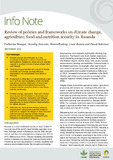| dc.contributor.author | Mungai, C. | |
| dc.contributor.author | Amwata, Dorothy A. | |
| dc.contributor.author | Radeny, M. | |
| dc.contributor.author | Butare, L. | |
| dc.contributor.author | Solomon, D. | |
| dc.date.accessioned | 2021-07-12T09:49:33Z | |
| dc.date.available | 2021-07-12T09:49:33Z | |
| dc.date.issued | 2020-09 | |
| dc.identifier.citation | CGIAR Research Program on Climate Change, Agriculture and Food Security (CCAFS) | en_US |
| dc.identifier.uri | https://cgspace.cgiar.org/handle/10568/109687 | |
| dc.identifier.uri | http://hdl.handle.net/123456789/4716 | |
| dc.description.abstract | Rwanda is a small landlocked country in East-Central Af-rica and one of the world’s most densely populated coun-tries. Average rainfall in Rwanda is around 1000 mm per annum, with the annual temperature ranging from 16°C to 21°C (Mikova et al. 2015). Climate variability and ex-treme events in Rwanda are among the most significant factors influencing annual crop production. Climate varia-bility and extreme event-related shocks like drought and flooding have become more frequent, significantly affecting crop production. The Eastern and South Eastern regions are most affected by prolonged drought, while the Northern and Western regions receive heavy rains usually causing severe erosion, flooding and landslides. Extreme floods in the Western province, for example, often lead to signifi-cant losses of agricultural produce, destroyed plantations, agro-ecosystems and valuable infrastructure (Mikova et al. 2015). Increased incidences of landslides in the North Western part of the country are also an example of the negative impact of climate change in Rwanda (RoR 2006). | en_US |
| dc.language.iso | en | en_US |
| dc.title | Review of policies and frameworks on climate change, agriculture, food and nutrition security in Rwanda | en_US |
| dc.type | Technical Report | en_US |

